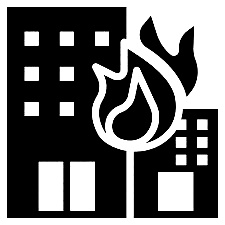There were two programmes that sparked this blog on fire safety, (yes, I am going to use lots of fiery words).
1. Watching Ablaze a Sunday Theatre’s drama piece. It provided an insider’s view of what happened during the 1947 Ballantynes Department Store fire. This was New Zealand’s worst fire disaster and resulted in the death of forty-one people.
2. Listening to The WorkSAFE Podcast Ep 26 Fire Safety. Brad Frazier, Assistant Fire Chief for the Columbia Fire Department, shares best practices to protect your people and your business from the dangers of a workplace fire.
What happened at Ballantynes on the 18th of November 1947?
3:31 pm Employees first smelt smoke and tried to call the fire brigade. There were no flames or sounds of a fire at this time. The exact cause of the fire remains unknown.
3:46 pm Another call was made to the fire brigade and the customers and employees on the first two floors were evacuated
3:47 pm Fire engines arrived, the focus was on the cellar, instead of the people trapped on the top two floors. A ladder truck was not called for. The building exploded in flames and the Fire Officer realising how serious the fire was tried to call for extra Fire appliances, but the phone lines were overloaded.
3.50 pm Office workers on the upper floor could not use the fire escape because of smoke and flames
4.30 pm Over 200 firefighters and 20 appliances attempted to bring the blaze under control
6.00 pm Firefighters began to search for bodies
8.00 pm Fires finally burned out completely
Key challenges
- Containment: Lack of smoke doors
- Escape: Lack of access to fire escapes
- Communication: Overloaded phone lines
- Building Design: A veranda around the building made it difficult for ladders to reach people
- Building Design: The lining of the building was highly flammable (Pinex and wooden match lining) this along with all the consumables in the department store meant there was a high fire load (lots of stuff that would burn quick).
- Building Design: No sprinklers
- Fire Officer Leadership: The commission of inquiry found that there were not enough trained Fire Officers in Christchurch and the rescue efforts were hindered by lack of coordination and leadership.
- Civic Failure: The building was unsafe and did not meet city building regulations, yet it had been inspected and passed for years earlier.
- Store Management Failure: There was no fire evacuation plan and employees had not been trained in what to do if there was a fire.
Outcomes: How have we learnt to ‘Do Better’ when it comes to Fire Safety
According to the commission of inquiry, the fire hazard could have been reduced by –
- The installation of an automatic sprinkler and fire alarm system
- An automatic fire-alarm system directly connected to the fire station
- The provision of adequate fire-doors
- The total prohibition of the use of untreated softwood fibreboard
- The provision of standpipes throughout the building with hoses attached
- The enclosure of lift-shafts and stairways by smoke-stop partitions.
As a result, the New Zealand Standard Code of Building Bylaws, Part VII (Means of Egress) was adopted and the basic principles can still be found in today’s Building Code which is part of the Building Act 2004.
What did Brad Frazier, Assistant Fire Chief for the Columbia Fire Department have to say about Fire Safety?
I always enjoy finding out how other jurisdictions sort their world out. Columbia, South Carolina has a population of around 120,000 people. The CFD employs 142 full-time workers over 3 shifts. There are 10 fire stations, 12 front line trucks and at any given time, there will be 42- 48 firefighters ready to go.
Here are some things Brad looks for when he does an inspection:
- Emergency plan in place and tested
- Avoid ‘daisy-chaining’ electrical cords in offices
- Keep heaters away from burnable material and don’t leave them on overnight.
- Check that you have the right type of fire extinguishers
- Check that you have minimised the amount of hazardous substances on site
- Spill containment either built-in or ready to go
- Flammable product secondary containment (HSNO lockers/fire doors etc)
- No exposed wires, damaged cords
- Alarms, sprinklers and emergency lighting is working
- Lunchrooms areas are kept clean i.e. no burning fat and grime in ovens
Turns out a lot of what Brad had to say can be found on the Fire and Emergency NZ website and the ‘Safety Check List’ is worth reading. Beyond the obvious, have you….
- Placed outdoor rubbish bins or skips away from your building?
- Adequatly fenced your workplace?
- Installed security lighting?
- Ensured exists are not locked, barred, or blocked?
- Made sure rubbish or other waste is not in stairwells and passageways?
As always, if you have anything to add to the discussion on workplace fire safety please call Sarah on 0272 007 680 or email sarah@employmenow.co.nz.
Have a safe and productive week,
SB
